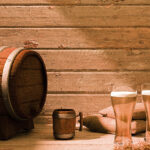by Buck Reed
Rocking Ramen
It is a well-known fact that every ancient civilization made some form of alcoholic beverage—let’s call it beer, if they were going to advance that culture (I will make the case in a future article!). No one person in these societies is credited with inventing this beverage. Every single one of them considered it a gift from a higher being, or God. So, let’s start with the ingredients that make the flavors of beer, and maybe in this series, we can prove God exists.
Water is the bulk of what makes beer. For the most part, if you can drink the water, you can make beer with it. There are slight differences in the water from place to place, but mostly this is a matter of the minerals you might find in different regions. These minerals, or lack of them, can influence the beer’s flavor, but for the most part, they are slight.
Grains are the next-largest ingredient used for beer. Mostly barley is used to make beer, and this grain is malted. The malting process involves laying the grains out and wetting them down so that they germinate. Once they go through this process, they are cooked in a kiln to create color and flavor for our beer. These malted grains are cooked to color, which is measured in Lovibond (an older, yet still common, method for measuring the color of beer that was developed in 1885 by Joseph Williams Lovibond). The higher the number of this scale, the darker the grain will be. When used to make beer, these grains add color, body, mouthfeel, and flavor to the beer.
Hops are a fast-growing herb that comes in many varieties and adds bitterness to our beers. The bitterness is measured in Alpha Acid units, with the lower numbers representing less bitterness; as the number increases, so does the bittering properties of the hop. Hops are also regional, so the hops used in an English ale would be different from an ale made in Belgium. Hops add flavor, help keep the beer sanitary, and also add head retention to our beers.
Yeast is a single-celled organism that converts the sugars in our beer into alcohol. These yeasts are traditionally regional and contribute distinct flavors to our various beers. Some yeasts like Scottish will add a flowery flavor to our beer, whereas, a German wheat beer will have a banana flavor. A good brewer will manipulate these yeasts to lessen or increase these flavors.
Other ingredients include specialty grains, like rye or flaked oats, to add their own distinct properties to beers. Also, flavorings like herbs and spices, as well as fruits and vegetables, are added to create unique flavors. Ingredients like peanut butter or Captain Crunch can be added to flavors in beers as well. Although, this writer will say that is not my thing, but insists you be you.


